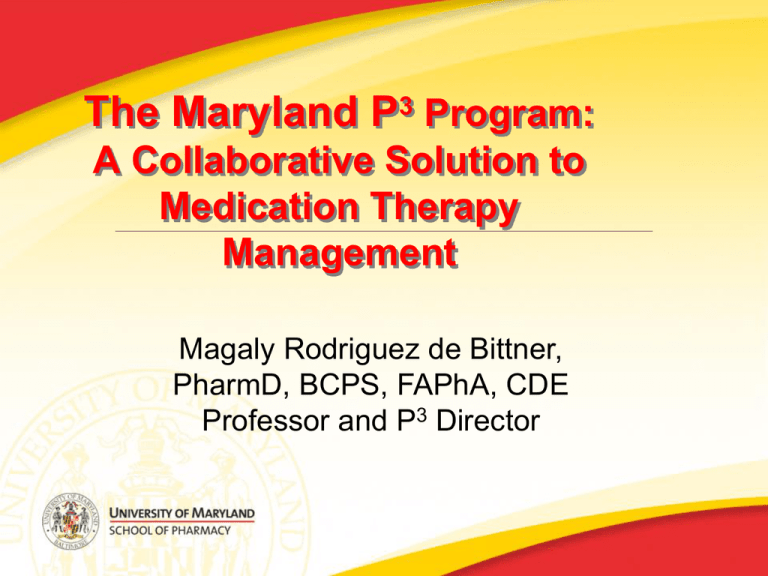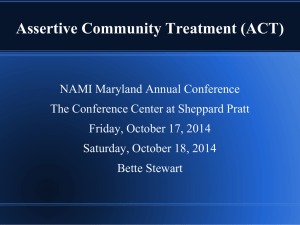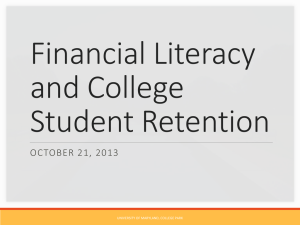
The Maryland P3 Program:
A Collaborative Solution to
Medication Therapy
Management
Magaly Rodriguez de Bittner,
PharmD, BCPS, FAPhA, CDE
Professor and P3 Director
Outline
Pharmacy Education
Program Overview
Preliminary Program Results
Impact on Public Health Needs
© 2006 University of Maryland School of Pharmacy. All rights reserved.
Patients Pharmacists
Partnerships (P3) Program
An effective solution to
patient-centered health
education, medication
adherence, and chronic
disease management
© 2006 University of Maryland School of Pharmacy. All rights reserved.
Chronic Care Model
Community:
Resources
and Policies
SelfManagement
Support
Informed,
Activated
Patients
Health System:
Health Care Organization
Delivery
System
Design
Productive
Interactions
Decision
Support
Clinical
Information
Systems
Prepared,
Proactive
Practice Team
© 2006 University of Maryland School of Pharmacy. All rights reserved.
Maryland P3
(Patients, Pharmacists, Partnerships)
Maximizes the role of the pharmacist (medication
expertise)
Pharmacists serving as “coaches” to stress selfmanagement education
Delivery system design
(aligned incentives, convenient location)
Decision support working collaborative with the
patient’s physician and other health care providers
Data Collection System-MedPath
© 2006 University of Maryland School of Pharmacy. All rights reserved.
• This pharmacist-delivered diabetes management initiative arose
out of an effort to improve patient health and reduce employer
health costs
• Began in 2006 with one employer in Western Maryland
• Now involves 6 employers and ~500 employees
• Support from DHMH and the Maryland Legislature
• Patients engaged in self-management
• Employers provide benefits and waive co-pays
• Pharmacists deliver care and coordinate care with
primary care providers and specialists
© 2006 University of Maryland School of Pharmacy. All rights reserved.
medication experts on the health care team
•
•
•
•
•
•
•
Meet face-to-face with patient 5-7 times depending on patient needs
Counsel patients on medication adhering and self-management
Educate patients on medication, and possible drug interactions, as well as
adverse effects
Coach patient in self-management skill development
Help with personal goal setting (therapeutic indicators)
Coordinate referrals for necessary
laboratory tests and specialist visits
(annual eye and foot exams, and
dental check ups)
Immunizations for pneumococcal
and influenza
American Diabetes Association Clinical Care Guidelines (2011)
© 2006 University of Maryland School of Pharmacy. All rights reserved.
Patients
Pharmacists
•Maryland
Pharmacists
Association
•P3 Pharmacy
Network
Self-management of
chronic disease
Partnerships
UMB School of
Pharmacy
Network Coordination
•Department of Health
and Mental Hygiene
Training
•Maryland General
Assembly
PSM System/Reporting
•Employers/Payers
© 2006 University of Maryland School of Pharmacy. All rights reserved.
Results From Early Program
Implementations
© 2006 University of Maryland School of Pharmacy. All rights reserved.
Total Healthcare Costs (Rx and Medical)
Mission Hospitals & City of Asheville
Combined
$8,000
Avg. U.S. 7,008
Avg. / Diabetes patient / Year
$7,000
U.S. 7,239
$7,042
U.S. $7,485
U.S. $7,762
U.S. $8,088
U.S. $8,468
ALL plan employees
National avg. ALL employees
$6,000
$5,000
$4,669
$4,288
$4,677
$4,371
$4,129
$4,000
$3,000
$2,000
$1,000
$0
Prior to Program
n = 164
Other Rx
Diabetes Rx
Medical Claims
1997
n = 47
1998
n = 72
1999
n = 131
2000
n= 147
Prior to program & each year of the program for 1st 5 years
note 10 participants were new employees that did not have baseline economic data
2001
n = 174
Baseline, Year 1, 2 and 3 compared to
Projected Costs*
Average Annual Costs to Employer for Participants
Year 3 Projected
$14,000
$12,000
$10,000
$8,000
$6,000
$4,000
$2,000
$0
Baseline
$9,035
Yr 1 Projected
Year 2 Projected
$10,390
$11,948
$13,740 Yr 3
savings
Per
Patient
from
projected
Costs
$6,250
Baseline 2002
Year 1 Actual
Year 2 Actual
Year 3 Actual
Pharmacist
$0
$414
$268
$240
Medication
$1,667
$3,045
$3,748
$3,093
Medical
$7,368
$5,454
$4,786
$4,157
Total costs
$9,035
$8,913
$8,802
from
Baseline
Costs
$1,545
$7,490
*for 63 patients with baseline,1st, 2nd and 3rd year results
© 2006 University of Maryland School of Pharmacy. All rights reserved.
Patient Self-Management ProgramSM
for Diabetes: First Year Cost Savings
J Am Pharm Assoc. 2005; 45: 130-137
Average Cost Per Patient
$10,000
$8,000
$6,000
$4,000
$2,000
Average
$0
Cost
Projected Year 1
Actual Year 1
$0
$351
MTMS
Savings
$3,128
$3,373
Medication
Per
$6,254
$4,740
Medical
Patient
$918
Combined data from Mohawk, VF, Manitowoc, OSU, Kroger (n=165)
© 2006 University of Maryland School of Pharmacy. All rights reserved.
The Diabetes Ten City Challenge
Interim Results: n=914, 10.2 months
Through 30-Sep-07, 29 employers, 10 cities:
– Charleston, South Carolina
– Chicago, Illinois
– Colorado Springs, Colorado
– Cumberland, Maryland
–
–
–
–
–
–
Honolulu, Hawaii
Milwaukee, Wisconsin
Northwest Georgia
Pittsburgh, Pennsylvania
Los Angeles, California
Tampa Bay, Florida
J Am Pharm Assoc 2008;48:181-190.
© 2006 University of Maryland School of Pharmacy. All rights reserved.
CAN THE P3 PROGRAM
MODEL IMPROVE CLINICAL
OUTCOMES AND DECREASE
HEALTH CARE COSTS FOR
PEOPLE WITH DIABETES?
© 2006 University of Maryland School of Pharmacy. All rights reserved.
© 2006 University of Maryland School of Pharmacy. All rights reserved.
© 2006 University of Maryland School of Pharmacy. All rights reserved.
Figure 4. Blood Pressure at Therapeutic Levels (mmHg)
Key
< 130/80
< 140/90
© 2006 University of Maryland School of Pharmacy. All rights reserved.
Results 2009 (N= 159 patients )
40
P3 Participants HbA1c Status Pre and Post
Intervention
35
30
25
20
Pre
15
Post
10
5
0
Alc 8.1-9
A1c 7.0 to 8.0
Alc 6.6 to 6.9
Alc < or = 6.5
© 2006 University of Maryland School of Pharmacy. All rights reserved.
Results 2009 (N=159)
© 2006 University of Maryland School of Pharmacy. All rights reserved.
Results 2009 (N=159)
Comparison of National HEDIS Commercial Rates (2009) vs. P3
Participants
100.0%
90.0%
80.0%
70.0%
60.0%
P3 Participants
50.0%
National HEDIS Commercial
40.0%
30.0%
20.0%
10.0%
0.0%
A1c Control < 8.0%
BP Control < 130/80 mm Hg BP Control <140/90 mm Hg
LDL < 100 mg/dL
© 2006 University of Maryland School of Pharmacy. All rights reserved.
Cost Savings for the Maryland P3
Program
On average our employers are saving
approximately $900 per employee per year
($495-$3,281).
© 2006 University of Maryland School of Pharmacy. All rights reserved.
Track Record of Success:
Clinical outcomes:
improvement in clinical indicators such as A1C and LDL
measures
Economic outcomes:
reduced overall costs of care
Satisfaction results:
high employee satisfaction with the program and
pharmacist care
© 2006 University of Maryland School of Pharmacy. All rights reserved.
Implications:Public Health Issues
1. Underserved Populations
2. Health care Reform- Patient Centered Medical
Home and Transitioned of Care
3. Team-based Care
4. Access to Health Care and Prevention
Services
© 2006 University of Maryland School of Pharmacy. All rights reserved.
2010 Recipient of the APhA Foundation Pinnacle
Award
© 2006 University of Maryland School of Pharmacy. All rights reserved.
Conclusions/Lessons Learned
1. Pharmacists are an innovative and effective solution to
control chronic disease by improving clinical, humanistic and
economic outcomes
2. Pharmacists accessibility and geographic location-in every
patient’s neighborhood- has a significant strategic potential
3. Collaboration between the Departments of Health/Office of
Chronic Diseases, academic institutions, professional
organizations and private employers have proven to be
effective maximizing resources and increasing efficiency of
chronic disease initiatives
© 2006 University of Maryland School of Pharmacy. All rights reserved.








